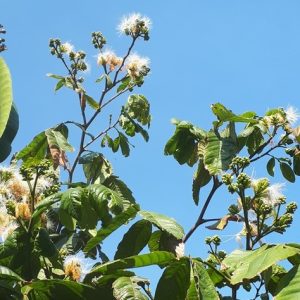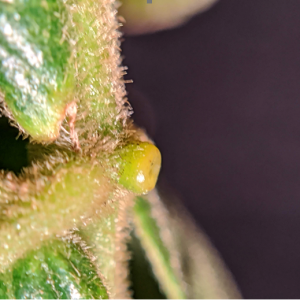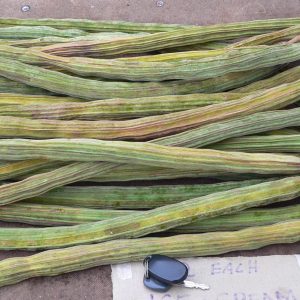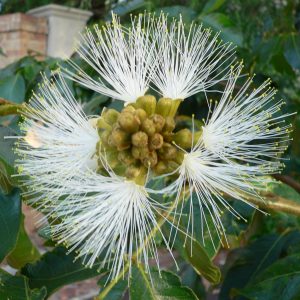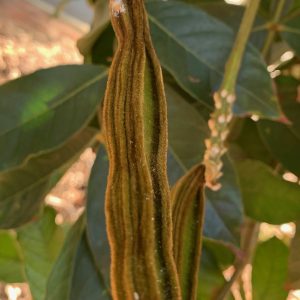Inga edulis
Inga, ice cream bean
Origin
It is native to tropical South America and was long ago spread throughout Central America.
Climate
Prefers lowland moist and hot tropics but adaptable to sub-tropical conditions in native highlands up to 2000m. Optimal mean temperature range is 21-28°C but can withstand up to 33°C. Best rainfall is 1200mm pa, but 3000mm with periods of waterlogging or areas with a dry season of 3-4 months are tolerated.
Plant Description
It is an evergreen tree, to 15m, with a broad spreading canopy. Young twigs are angular in cross-section and covered with short brown hairs. Leaves are pinnate with 4-6 pairs of opposite leaflets, the terminal pair being larger than those at the base. Each pair is separated by a distinctive winged rachis with a central nectary gland. Rapid growth is usual in its favoured environment.
Relatives
Inga species are members of the Fabaceae Family which also includes peanut, carob, tamarind and licorice, and are excellent nitrogen fixers.
Soils
It prospers in soils of all types within an extended pH range of 4-8. A symbiotic association with nitrogen-fixing bacteria and mycorrhiza is formed, giving it an exceptional endogenous nutritional capacity. As a consequence it grows in poorly fertile soils where many other plants struggle, and it will also improve surrounding soil fertility. It can handle some waterlogging.
Propagation
Exclusively by seeds which germinate rapidly and easily. However they are recalcitrant and viviparous so need to be sown fresh. Amazonian farmers prefer trees that produce deep black seeds (which they call ‘female’) over lightly coloured ones (called ‘male’) as the former are more productive. Some varieties produce polyembryonic seeds.
Cultivars
None. However over many centuries, opportunistic selection of superior trees has resulted in cultivated types being better than those growing wild.
Flowering and Pollination
Flowers are arranged in dense axillary spikes. They are androgynous and tubular with many showy white stamens. A 3-4 year old plant may produce up to 100,000 flowers but fruit set is only about 1%. This may be improved with cross-pollination. The fragrant flowers and nectaries attract bees and other insects which are thought to effect pollination.
Cultivation
It should be planted where it will receive full sunlight. Inter-cropping with other fruit trees such as coffee and cacao is common, as they provide shade and soil enrichment.
Wind Tolerance
Apart from their many other uses, they are sometimes used as windbreaks.
Pruning
They can be coppiced quite severely for structural reasons and will continue to be fruitful. Large trees may need to be pruned constantly, and the prunings can be used as firewood.
The Fruit
It is a large green indehiscent ridged pod, up to 1.5m long, filled with 2-3cm long black seeds which are surrounded by a white cottony edible pulp containing 15-20% carbohydrates. They take several months from flowering to mature.
Among the species other than edulis, the size and appearance of the pods varies widely, as does the flavour and quality of the pulp.
Fruit Production and Harvesting
Under ideal conditions the first fruit may set within 2 years, and by the fifth there may be up to 300 pods. Inga is a very productive tree with yields of over 1000kg/tree reported. Mature fruit do not abscise and must be picked. The pod pulp, 20% of fresh fruit weight, is accessed by twisting the fibrous pericarp. Fruiting season is approximately May through August. Fruits are harvested when fully rounded.
Fruit Uses
Usually eaten fresh but also in processed forms. In South America they are used for the production of the alcoholic beverage, cachiri. In Mexico, pods are roasted.
Pests and Diseases
Pod-boring insects, fungus. Healthy and vigorous trees are generally free of major problems. However moist and humid climates can increase the risk of fungal diseases.
Comments
The genus has more than 300 species with some 50 producing edible fruit. There is not a lot of published material about them, and it is difficult to identify species. There are many variations in appearance, eating quality and growth habits.
If you buy “Inga edulis” seeds or plants, be advised that nurseries also are often incorrect about the identity of what they are selling.
This is a versatile and hardy fruit tree that can be extremely productive, and it’s kind to home growers, with fruiting over a staggered period. If you are inclined to grow one, try and ensure it’s propagated from one of the long black ‘female’ type seeds.
Of the Inga species, only I. edulis is invasive. It is deemed an environmental weed in the shires between Taree and Tweed on the East Coast (no reports of problems in WA).
